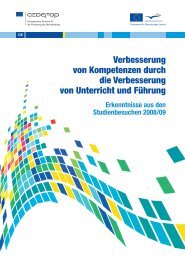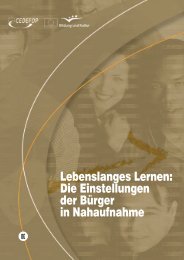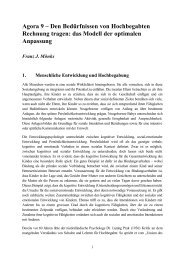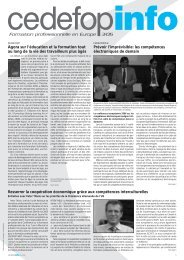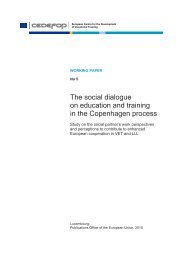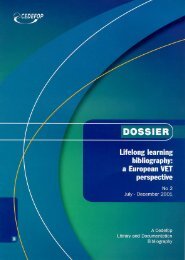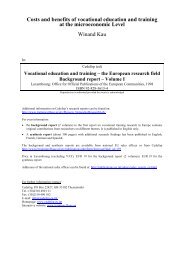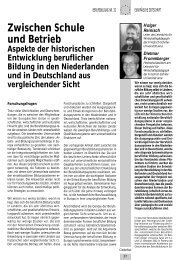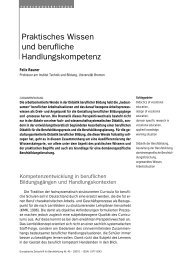Full text (pdf) - Cedefop - Europa
Full text (pdf) - Cedefop - Europa
Full text (pdf) - Cedefop - Europa
Create successful ePaper yourself
Turn your PDF publications into a flip-book with our unique Google optimized e-Paper software.
Key words<br />
ECVET,<br />
ECTS,<br />
EQF,<br />
mobility,<br />
credits,<br />
qualification,<br />
transparency of<br />
qualifications,<br />
credit systems<br />
THEMATIC ISSUE: THE EUROPEAN<br />
QUALIFICATIONS FRAMEWORK<br />
Qualifications frameworks<br />
and credit systems:<br />
a toolkit for education<br />
in Europe<br />
Torsten Dunkel<br />
Senior Researcher, Kassel International Centre for Higher Education Research (INCHER),<br />
University of Kassel, Germany<br />
Isabelle Le Mouillour<br />
Project Manager and Senior Researcher, Federal Institute for Vocational Education and<br />
Training (BIBB), Germany, International Monitoring and Benchmarking / European VET<br />
Policy Section<br />
SUMMARY<br />
Europe should become the most competitive and dynamic knowledge-based economy<br />
in the world by 2010, while at the same time safeguarding social cohesion. In<br />
the field of education policy, this aim is being pursued by means of a comprehensive<br />
programme for the creation of a European Higher Education Area (EHEA) as part<br />
of the Bologna Process, and in the VET sector through the so-called Copenhagen<br />
Process. On the way towards an integrated European Higher Education Area in 2010,<br />
the European Commission’s proposal for a European Qualifications Framework (EQF)<br />
offers opportunities on the one hand for increased mobility within the higher education<br />
sector, especially at European level and, on the other, for mobility or enhanced<br />
permeability between education sectors. Further development of the ECTS and<br />
ECVET credit systems from a function of transfer to one of accumulation, and from<br />
an input-based to an outcome-related orientation, should promote enhanced mobility<br />
of students, trainees, graduates and workers through the accreditation and recognition<br />
of acquired knowledge, skills and competences; it should also facilitate access<br />
to education and VET and the development of comprehensive continuing training<br />
which lasts an entire (working) year. It is against this background that the characteristics<br />
of, and interactions between, these instruments will be explored.<br />
European journal of vocational training – No 42/43 – 2007/3 2008/1 – ISSN 1977-0219
Introduction<br />
Qualifications frameworks and credit systems: a toolkit for education in Europe<br />
Torsten Dunkel, Isabelle Le Mouillour<br />
Barriers to mobility are falling in Europe. For students, trainees, graduates<br />
and workers wishing to find employment elsewhere, as well as for their employers,<br />
this means that qualifications and experience acquired somewhere<br />
else need to be properly assessed in the new place of work or at the start (or<br />
resumption) of learning activity in another education system. Transparency<br />
and recognition of acquired competences and qualifications are required to<br />
this end.<br />
The Lisbon Agenda of 2000, with its goal of making Europe the most competitive<br />
and dynamic knowledge-based economy in the world by 2010, constituted<br />
the political (and economic) starting-point for the EU in this respect.<br />
This goal is being put into practice, on the one hand thanks to the Sorbonne<br />
Declaration (1998), the Bologna Declaration (1999) and their follow-up conferences<br />
in Prague (2001), Berlin (2003), Bergen (2005) and London (2007)<br />
– the so-called Bologna Process – and, on the other, in respect of vocational<br />
education and training (VET), through the Copenhagen Declaration (2002)<br />
and the Communiqués of Maastricht (2004) and Helsinki (2006) – the socalled<br />
Copenhagen Process. Various instruments, mechanisms and principles<br />
to promote lifelong learning have been developed in the con<strong>text</strong> of<br />
the Copenhagen Process. These include the European Credit Transfer System<br />
for VET (ECVET) and the Common Quality Assurance Framework for<br />
VET in Europe (CQAF). In parallel, instruments and principles to promote<br />
lifelong learning, the creation of the European Higher Education Area (EHEA)<br />
and mobility have been adopted in the higher education sector, mainly in<br />
the con<strong>text</strong> of the Bologna Process. These include the introduction of three<br />
study cycles (bachelor, master and doctorate) in higher education and the<br />
implementation of the European Credit Transfer and Accumulation System<br />
(ECTS). Some new or redeveloped instruments have been adopted in order<br />
to make vocational training more attractive in Europe, to reinforce the<br />
link between VET and the labour market, and to enhance opportunities for<br />
progressing into higher education (Maastricht Communiqué, 2004): these<br />
instruments, in addition to the European credit systems ECVET and<br />
ECTS, are the European Qualifications Framework (EQF) and the <strong>Europa</strong>ss<br />
Mobility and its Diploma Supplement. All formally and informally acquired<br />
competences, as well as every diploma acquired by an individual, are entered<br />
in the <strong>Europa</strong>ss, which thus documents that person’s entire educational<br />
background. The Diploma Supplement is an additional sheet in the<br />
<strong>Europa</strong>ss listing the competences associated with a diploma. This simpli-<br />
185
186<br />
European journal of vocational training<br />
No 42/43 – 2007/3 2008/1<br />
fies its transfer to National Qualifications Frameworks (NQF) or other national<br />
systems.<br />
The purpose of both processes (Bologna and Copenhagen) is to ensure<br />
permeability, transparency and mobility in the education sector (Dunkel, 2007).<br />
Although the two processes are being coordinated, there is little congruence<br />
between them so far. This is particularly apparent when one considers the issue<br />
of progression between VET and higher education or the development<br />
of the European Qualifications Framework. What are the characteristic features<br />
of ECVET, ECTS and EQF, and how are these instruments coordinated<br />
with one another? To answer these questions, their objectives and functions<br />
are compared methodically in section 1. Section 2 then analyses their<br />
individual elements and components. Section 3 discusses the role and significance<br />
of credits, and a number of conclusions are drawn in the fourth and<br />
final section.<br />
Objectives and functions<br />
The objectives of EQF, ECVET and ECTS combine educational and socio-economic<br />
arguments, as illustrated by the following table. It is a matter<br />
both of promoting the competitiveness of Europe as a location (growth and<br />
employment are EU aims laid down by the Lisbon Strategy) and of fostering<br />
the personal and occupational development of individuals in Europe. ECTS<br />
was first devised in 1984 as an instrument for the recognition of short-term<br />
study visits within the ERASMUS programme (student mobility in Europe) and<br />
was subsequently taken up by the Bologna Declaration as an ‘instrumental<br />
objective’ at the initiative of the Ministries of Education. Only in 2002, in the<br />
con<strong>text</strong> of the Copenhagen Declaration, was ECVET advocated as an instrument<br />
for the recognition of competences and qualifications at the initiative of<br />
the Ministries responsible for VET and of the European Commission. Both ECTS<br />
and ECVET are European credit transfer and accumulation systems, one for<br />
the higher education sector and the other for VET. ECVET does not determine<br />
a credit system for qualifications at national or sectoral level; rather it<br />
serves as an international framework of reference. ECTS has, over the years,<br />
been incorporated into the higher education legislation and regulations of almost<br />
all the countries participating in the Bologna Process (European Commission,<br />
2006c). The EQF is a framework of reference intended, inter alia, to<br />
facilitate the allocation of similar qualifications or parts of qualifications at the<br />
appropriate level and consequently to ensure cooperation and comparabili-
Goals<br />
instruments EQF ECVET ECTS<br />
Transparency Improving the transparency of qualifications and<br />
lifelong learning (Lisbon goals)<br />
Promotion of Europe as a<br />
location<br />
Making Europe the most competitive and dynamic<br />
knowledge-based economic area by the year 2010<br />
(Lisbon goals)<br />
Mobility No direct explicit link in<br />
the documents analysed<br />
Comparability Comparability of qualifications<br />
Transferability (transfer,<br />
accumulation)<br />
Recognition<br />
Validation<br />
Transferability of qualifications<br />
Recognition and validation<br />
of non-formal and<br />
informal learning<br />
Cooperation Promoting cooperation<br />
and strengthening trust<br />
among all concerned (3)<br />
Qualifications frameworks and credit systems: a toolkit for education in Europe<br />
Torsten Dunkel, Isabelle Le Mouillour 187<br />
ty. The connection between ECTS and EQF can be clarified by examining EQF<br />
levels 5-8. These levels are set in accordance with the Bologna indicators for<br />
higher education as part of the qualifications framework for the European Higher<br />
Education Area, the so called ‘Dublin descriptors’. These descriptors were<br />
devised by an informal group of European experts, the so-called Joint Quality<br />
Initiative, with a view to defining the interdisciplinary and subject-specific<br />
competences to be acquired by students Europe wide in the course of a bachelor’s,<br />
master’s or doctoral study programme (JQI, 2007). Taking these into<br />
account in the EQF con<strong>text</strong> should contribute to permeability between VET<br />
and higher education.<br />
Table 1: Objectives of all three instruments<br />
Promoting the international<br />
mobility of learners<br />
(4)<br />
Comparability of qualifications<br />
Transferability of qualifications<br />
or partial qualifications<br />
Improving the quality of<br />
VET recognition and<br />
validation procedures<br />
(4)<br />
Promoting cooperation<br />
and trust among all<br />
concerned<br />
Improving the transparency<br />
of higher education diplomas<br />
International attractiveness<br />
of European higher education<br />
(2)<br />
Promoting student mobility<br />
(1)<br />
Developing international<br />
curricula (1)<br />
Comparability of study programmes<br />
Transferability of credit<br />
points<br />
Facilitates academic recognition<br />
(2)<br />
Promoting cooperation and<br />
trust among universities<br />
Source: This table is based on official European Commission documents describing and explaining EQF, ECVET<br />
and ECTS: 1 = ‘Berlin Communiqué, 2003’; 2 = European Commission, 2004, p. 1; 3 = European<br />
Commission, 2006a, pp. 2-3; 4 = European Commission, 2006b.
188<br />
European journal of vocational training<br />
No 42/43 – 2007/3 2008/1<br />
This table needs to be complemented by a more nuanced consideration.<br />
The European Qualifications Framework serves as a reference point to make<br />
the individual National Qualifications Frameworks (NQF) or qualifications comparable<br />
with one another (bilaterally and multilaterally). The NQFs or qualifications<br />
of different systems are compared with each other by means of the<br />
EQF meta-framework, which facilitates their transfer to other systems. The<br />
EQF operates as a passive instrument in this sense. The key role of the EQF<br />
in the implementation of the European Union’s overall education strategy finds<br />
expression in particular through its links with other instruments of transparency<br />
(the European Higher Education Area Qualifications Framework, <strong>Europa</strong>ss,<br />
ECTS, ECVET, principles for the validation of non-formal and informal learning<br />
(Schneeberger, 2006)).<br />
Credit systems are devised as instruments which are broadly and directly<br />
applicable in a mobility con<strong>text</strong>, by way of ‘all-in-one’ or ‘ready-made’ solutions,<br />
even though they may develop further over the years, as ECTS has<br />
done. Credit systems serve a number of general purposes:<br />
transfer of learning outcomes within and between education systems, or<br />
of learning outcomes acquired in formal and informal settings;<br />
accumulation and mutual recognition of learning activities or partial qualifications<br />
until the qualifications are completed;<br />
cooperation between VET providers across national borders;<br />
transparency of learning processes and learning outcomes through joint<br />
adherence to the EQF;<br />
flexible accreditation of study periods, study programmes and curricula by<br />
independent decision of the competent (national) bodies;<br />
as far as possible, simplification and activation of certification and validation<br />
procedures at all levels (<strong>Cedefop</strong>; Le Mouillour, 2005).<br />
ECTS relates to the higher education sector, while ECVET is intended for<br />
VET (in particular initial training) in the first instance; both will also be applied<br />
in the field of lifelong learning at a later stage (European Commission, 2004;<br />
European Commission, 2006b). For the time being, ECTS and ECVET differ<br />
in scope and coverage. This becomes clear when one examines their respective<br />
definitions:<br />
The ECTS was conceived on the basis of the following definition: ‘A credit<br />
system is a systematic way of describing an educational programme by<br />
attaching credits to its components’ (European Commission, 2004, p. 1);<br />
ECVET is ‘a mechanism designed to facilitate learners’ mobility by supporting<br />
cooperation among partner organisations in the international ac-
Qualifications frameworks and credit systems: a toolkit for education in Europe<br />
Torsten Dunkel, Isabelle Le Mouillour 189<br />
cumulation and transfer of credit for learning outcomes in VET’ (European<br />
Commission, 2006d, p. 11).<br />
Each programme has its own specific objectives in addition to the above<br />
educational goals:<br />
ECTS in relation to students: ‘ECTS makes study programmes easy to read<br />
and compare for all students, local and foreign’; and in relation to universities:<br />
‘ECTS helps universities to organise and revise their study programmes’<br />
(European Commission, 2004, p. 1);<br />
ECVET in relation to learners: ‘(…) a way of enabling people to pursue their<br />
learning pathway by building on their learning outcomes when moving from<br />
one learning con<strong>text</strong> to another, in particular in the framework of mobility.<br />
(...) to improve access to qualifications for all, throughout their lives’ (European<br />
Commission, 2006b, p. 8); and in relation to the bodies responsible<br />
for national VET systems: ‘proposes a common approach to describing qualifications<br />
in order to make them easier to understand from one system to<br />
another, and to describing the procedures for validating learning outcomes’<br />
(European Commission, 2006b, p. 8).<br />
ECTS and ECVET can therefore be distinguished in two areas: the target<br />
groups (students vs. learners) and the role of credits. Students constitute<br />
a specific group of learners, who are attending university in a particular<br />
phase of their learning trajectory and receive credits in the con<strong>text</strong> of<br />
ECTS. In the case of ECVET, the learner is in a vocational training phase.<br />
ECTS credits are regarded as a tool for managing study programmes (for<br />
both higher education establishments and students). ECTS credits correspond<br />
to a certain student workload for a year of full-time study. Both universities<br />
and students can allocate their resources accordingly. ECTS credits<br />
likewise help universities to organise and revise their curricula. In the<br />
case of ECVET, credits serve to make learning outcomes more transparent<br />
and transferable, the basic dimension here being the all-round occupational<br />
profile of the person concerned. Most VET systems have standard<br />
occupational profiles which can be used to define learning outcomes for<br />
ECVET (<strong>Cedefop</strong>; Le Mouillour, 2005).<br />
Both credit systems achieve their respective objectives by means of ‘transfer’<br />
and ‘accumulation’. The purpose and ultimate aims of these two functions<br />
can be distinguished as follows:<br />
in ECTS, credits are transferred in the con<strong>text</strong> of international mobility agreements<br />
(cf. European Commission, 2004, p. 2). This means that the learn-
190<br />
European journal of vocational training<br />
No 42/43 – 2007/3 2008/1<br />
ing effort expended abroad by the student is transferred and integrated into<br />
the study programme at home;<br />
in ECVET, the learner must have passed the examination abroad or possess<br />
evidence of the additional learning outcomes acquired. The ‘learning<br />
outcomes’ acquired by the learner abroad are what is transferred under<br />
ECVET. This likewise occurs in the con<strong>text</strong> of international mobility agreements;<br />
accumulation is a new and as yet incomplete development in the case of<br />
ECTS, which is ‘developing into an accumulation system to be implemented<br />
at institutional, regional, national and European level’ (European Commission,<br />
2004, p. 1);<br />
accumulation is regarded as an important aspect of ECVET from the outset:<br />
learning outcomes are accumulated, and this accumulation takes place<br />
with a view to the learner’s acquisition of a particular qualification. That qualification<br />
is normally awarded in the learner’s country of origin.<br />
According to the ‘Trends V’ report of the European University Association<br />
(EUA), 75 % of the 908 universities surveyed, which had implemented ECTS,<br />
stated that they used ECTS as a transfer instrument; 66 % used ECTS as an<br />
accumulation instrument (Purser, Crosier, 2007b). The change in the function<br />
of credit systems from transfer alone to accumulation, or from an inputled<br />
approach (in the sense of student workload or learning effort) to an approach<br />
driven by learning outcomes, corresponds to the concept of lifelong<br />
learning and the new notion of learning and working phases in individual biographies.<br />
In this sense there is a need for procedures and rules on the accreditation<br />
and validation of learning outcomes between different components<br />
of education systems (higher education; initial, further and continuing vocational<br />
training) and between different modes of learning. The consideration<br />
of learning outcomes in connection with credit systems offers an opportunity<br />
to validate learning outcomes acquired formally, non-formally and informally<br />
for VET or university study programmes, thereby facilitating permeability<br />
and progression between educational systems.
Table 2: Bases of EQF, ECVET and ECTS<br />
Basis EQF ECVET ECTS<br />
The following<br />
elements are<br />
applied in EQF,<br />
ECVET and ECTS<br />
Learning outcomes<br />
Qualification<br />
Qualifications frameworks and credit systems: a toolkit for education in Europe<br />
Torsten Dunkel, Isabelle Le Mouillour 191<br />
From learning outcomes to qualifications<br />
Learning outcomes, competences and qualifications form a common semantic<br />
basis for EQF, ECVET and ECTS. We shall discuss below their application<br />
and embodiment in the respective educational systems. Table 2 compares<br />
the respective definitions of ‘learning outcome’ and ‘qualification’.<br />
Descriptors<br />
8 levels<br />
Knowledge, skills and competence<br />
– The three cycles of the qualifications<br />
framework in the European<br />
Higher Education Area<br />
set out descriptors for each cycle<br />
based on learning outcomes<br />
and competences, and credit<br />
ranges in the first and second<br />
cycles (3)<br />
Learning/teaching/instruction methods or method of communicating<br />
knowledge<br />
– Different approaches<br />
to the calculation<br />
of credits<br />
‘Statements of what a learner knows, understands<br />
and is able to do on completion of a<br />
learning process (…) defined in terms of<br />
knowledge, skills and competence’<br />
(2, p. 16).<br />
‘A formal outcome of an assessment and validation<br />
process which is obtained when a<br />
competent body determines that an<br />
individual has achieved learning outcomes to<br />
given standards’ (2, p. 16)<br />
Calculation of credits on the basis<br />
of student workload<br />
The objectives of a learning programme<br />
are preferably specified<br />
in terms of learning outcomes<br />
and competences (1)<br />
Learning outcomes are sets<br />
of competences, expressing<br />
what the student will know, understand<br />
or be able to do after<br />
completion of a process of learning,<br />
long or short (1)<br />
Information on the qualification<br />
is a component of the checklist<br />
(a key document for ECTS)<br />
(1)<br />
Source: (1) = European Commission, 2004, p. 1; (2) = European Commission, 2006a; (3) Bergen Communiqué,<br />
2005
192<br />
European journal of vocational training<br />
No 42/43 – 2007/3 2008/1<br />
Differences between ECVET and ECTS derive from the fact that the former,<br />
unlike the latter, does not have many years of experience behind it. ECTS<br />
was first introduced in 1989 in the con<strong>text</strong> of the ERASMUS European mobility<br />
programme, while the first meeting of the European technical group on<br />
the development of a credit system for VET in Europe was held only in late<br />
2003. Mutual trust and understanding among universities themselves and with<br />
other tertiary-level institutions grew during that period. Non-governmental organisations<br />
(NGOs) such as the European University Association (EUA) and<br />
the European Association of Institutes in Higher Education (EURASHE) pursued<br />
common aims. At European level, furthermore, the Council of Europe,<br />
the European Students’ Union (ESIB) and UNESCO’s European Centre for<br />
Higher Education (UNESCO - CEPES) are involved as observers. The Bologna<br />
Process provides a framework for the introduction of a system of easily understandable<br />
and comparable higher education diplomas in all participating<br />
countries. The Bologna member countries have committed themselves to the<br />
process itself and exercise self control over the implementation of the Bologna<br />
priorities by means of stocktaking activities and follow-up groups.<br />
In VET, there is so far no common procedure and no NGO operating in<br />
the field. It is more difficult to develop a credit system for VET because, for<br />
example, in some countries, the holders of certain diplomas issued by VET<br />
colleges are awarded qualifications at levels typically achieved by university<br />
graduates at bachelor level in other countries. The advantage of ECTS<br />
over ECVET is that readily comparable institutional and curricular conditions<br />
and courses (including the time input) apparently make it easier to find a<br />
benchmark for learning outcomes in relation to study disciplines and curricula.<br />
The VET sector, by contrast, comprises a large number and variety<br />
of institutions, traditions, statutory regulations and forms of social recognition<br />
in each individual Member State. ECTS, in fact, says nothing about the<br />
content, composition or equivalence of study programmes. It has much more<br />
to do with quality issues, which universities must settle by means of bilateral<br />
or multilateral cooperation agreements. The starting-point for ECVET<br />
qualifications, on the other hand, is technical specifications (e.g. for knowledge<br />
and skills) and quality assurance procedures, as well as the assessment<br />
and validation of outcomes. In practical terms, ECVET is based on the<br />
one hand on the description of qualifications in the form of learning outcomes<br />
or knowledge, skills and competences and, on the other, on the award of<br />
credits for qualifications and units or modules. Credits will be discussed in<br />
the next section. Learning outcomes (see Table 3) are the main common<br />
element of ECVET, ECTS and EQF. However, the ‘learning outcomes’ for
Table 3: Learning outcomes<br />
Instrument Definition Interpretation<br />
EQF<br />
ECVET<br />
ECTS<br />
Qualifications frameworks and credit systems: a toolkit for education in Europe<br />
Torsten Dunkel, Isabelle Le Mouillour<br />
each of the three instruments are defined differently and specified to differing<br />
degrees.<br />
A combination of knowledge,<br />
skills and competence (1, p. 10). Competence<br />
is described in terms of responsibility<br />
and autonomy.<br />
Descriptions of what the learner knows,<br />
understands and is able to do, after completion<br />
of the learning process. They are<br />
defined as knowledge, skills and competence<br />
(2, p. 10).<br />
These outcomes are sets of competences,<br />
expressing what the student will<br />
know, understand or be able to do after<br />
completion of a process of learning,<br />
long or short (3).<br />
They make it possible to compare qualifications<br />
according to criteria such as<br />
content and profile (1, p. 10).<br />
These are elements which are collected,<br />
transferred and accumulated as units.<br />
Learning outcomes are inferred from the<br />
target vocational or qualifications profile<br />
(2).<br />
The objectives of a learning programme<br />
are preferably specified in terms of learning<br />
outcomes and competences (3).<br />
Learning outcomes are precisely defined<br />
for each course or module depending on<br />
the study discipline.<br />
Source: (1) = European Commission, 2006a; (2) = European Commission, 2006b; (3) European Commission,<br />
2004, p. 1.<br />
The implementation of a credit system requires the definition of small, manageable<br />
and transparent units which can be transferred relatively easily in a<br />
mobility con<strong>text</strong>. Caution is needed, however, when using the terms ‘units’ and<br />
‘modules’, since both terms translate into German as ‘Modul’. In ECVET, learning<br />
outcomes are grouped together in ‘units’, and a distinction can be drawn<br />
between units in the sense of ‘units of assessment’ and ‘modules’ in the sense<br />
of ‘modules of learning’. ‘Units’ are parts of a qualification and are based on<br />
a concentration of knowledge, skills and competences. ‘Modules’ represent<br />
a pedagogical/didactic view of the qualification and are defined as part of the<br />
educational programme (Le Mouillour, 2006; p. 26). In ECTS, modules are<br />
defined as ‘educational components of a study programme’ (European Commission,<br />
2004; p. 1), i.e. in the sense of ‘modules of learning’.<br />
Given the specific characteristics of VET in Europe, learning outcomes were<br />
deliberately made the cornerstone of ECVET. The problem of classifying learning<br />
outcomes according to vocational proficiency levels has been addressed<br />
in this connection. In 2004, Coles and Oates devised the basis for, and an<br />
193
194<br />
European journal of vocational training<br />
No 42/43 – 2007/3 2008/1<br />
initial draft of, a reference framework structure for VET. This study (<strong>Cedefop</strong>;<br />
Coles and Oates, 2005) is regarded as a blueprint for the development of the<br />
European Qualifications Framework (EQF). Nowadays, ‘the emerging European<br />
Qualifications Framework and its learning outcomes-based grid of reference<br />
levels is regarded as an important support instrument for the effective<br />
implementation of the ECVET system’ (European Commission, 2006d;<br />
p. 12). The differences in the definition and role of learning outcomes in ECTS<br />
and ECVET (see table 3) are crucial in the development of lifelong learning.<br />
Lifelong learning is not a continuum without any disruptions or frictional losses.<br />
The first ‘threshold’ comes with the transition from general to vocational<br />
education. Secondly, the gap between the education system and the labour<br />
market often has to be bridged (the second ‘threshold’), and thirdly there are<br />
the crossovers between general, vocational and higher education. Questions<br />
arise here about continuity in the vertical conception of the EQF levels and,<br />
hence, about the role of the credit points relevant to credit systems. No such<br />
credit points appear in the European reference framework (EQF), which focuses<br />
on learning outcomes.<br />
Significance and role of credits<br />
Analysis of the subject of credit systems and qualifications frameworks shows<br />
that, sooner or later, a sensitive issue comes up in the discussion: namely credits,<br />
or how to calculate them in specific, quantifiable figures. In other words,<br />
the crucial question as to the role of credit points.<br />
The Bologna Agreement among universities defines credits as components<br />
of study programmes, and the numerical value of such credits - so-called credit<br />
points - is transferred. Agreements on the calculation and allocation of ECTS<br />
credit points serve as a general con<strong>text</strong> for organising student mobility (see<br />
Table 4). In ECVET, credits – or ‘learning credits’ – are the certified results<br />
of an examination of learning outcomes, taken abroad. ECVET credits are transferred<br />
(European Commission, 2006b). It falls to the competent authorities in<br />
the respective countries to establish the numerical value of ECVET credits.<br />
These competent bodies vary from one VET system to another and may be<br />
either ministries, chambers of industry and commerce, sectoral organisations<br />
or training providers.
Table 4: Calculation and allocation of credits in ECTS and ECVET<br />
ECTS ECVET<br />
Value Numerical value Numerical value<br />
Assignment to Any type of course of study Units of learning outcomes<br />
Calculation The amount of work required of<br />
the student for each course of<br />
study must be described<br />
⇒ workload<br />
Allocation Per course of study, in relation<br />
to the total learning effort required<br />
for successful completion of<br />
an entire academic year<br />
Responsible for assignment<br />
and award<br />
Qualifications frameworks and credit systems: a toolkit for education in Europe<br />
Torsten Dunkel, Isabelle Le Mouillour<br />
Left open, not specified<br />
Per unit. Qualifications to be<br />
grouped into units as appropriate.<br />
Universities Body/bodies responsible for national<br />
VET system<br />
Assessment Abroad: local grading Abroad: local grading<br />
The ECTS grading scale (from<br />
A to F*) ranks the students on<br />
a statistical basis<br />
Source: European Commission, 2006b; European Commission, 2004.<br />
* A = excellent – the best 10 % of the student cohort; F = fail – considerable further work required<br />
A convention concluded between the main national players in the relevant<br />
educational sectors generally lies behind a credit system. In the field of higher<br />
education, institutional and organisational aspects of the educational programmes<br />
underpin the calculation of ECTS credits. ECTS is based on the principle,<br />
enshrined in a European convention, that 60 credits measure the workload<br />
of a full-time student during one academic year. The student workload<br />
of a full-time study programme in Europe amounts in most cases to around<br />
1 500-1 800 hours per year, and in those cases one credit stands for around<br />
25-30 working hours (European Commission, 2004). Student workload in ECTS<br />
consists of the time required to complete all planned learning activities such<br />
as attending lectures, seminars, independent and private study, preparation<br />
of projects, examinations, and so forth (European Commission 2004, p. 1).<br />
Two main calculation bases are used in the higher education sector: workload<br />
and notional learning time. ‘Notional learning time’ means the time needed<br />
by an ‘average’ learner to achieve the learning outcomes of a qualification<br />
or study programme. This period of time is only intended as a guide, how-<br />
–<br />
195
196<br />
European journal of vocational training<br />
No 42/43 – 2007/3 2008/1<br />
ever, and credit points are not deducted or added if more time or less is taken<br />
(see SCQF 2003).<br />
The problem of defining credit points nevertheless becomes apparent when<br />
one examines the implementation of ECTS in the higher education sector.<br />
Reichert and Tauch (2005) point out in their survey that higher education establishments<br />
still have difficulty with workload-based calculations. Furthermore,<br />
the calculation of credits on the basis of study programmes can in some<br />
cases lead to a variation in the number of credit points for one and the same<br />
course of study. The proposed method of calculating credits in the ECVET<br />
con<strong>text</strong> states that ‘120 ECVET credit points on average could be associated<br />
to the learning outcomes achieved by an individual in a year in a formal<br />
full time VET con<strong>text</strong>’ (European Commission, 2006b, p. 14). However, several<br />
methods are possible at national level for determining the number of credit<br />
points to be allocated: ‘the number of credit points allocated to a qualification<br />
and units can be determined on the base of the following criteria:<br />
the contents of a qualification in terms of range and/or volume of knowledge,<br />
skills and wider competences to be acquired;<br />
with reference to a notional average length of programme leading to such<br />
a qualification;<br />
by the amount of notional learning activities and workload necessary for<br />
a learner to attain the set of learning outcomes corresponding to a part or<br />
whole qualification (e.g. regarding a typical training programme or a training<br />
programme of reference)’ (European Commission, 2005a, p. 14).<br />
The difficulty of making the two credit systems compatible becomes palpable<br />
with respect to the composition, calculation and allocation of credits.<br />
The fundamental difference between ECTS and ECVET lies in their primary<br />
orientation: ECVET units and credits are defined in relation to qualifications<br />
and the associated learning outcomes; ECTS on the other hand is oriented<br />
according to study programmes. Concerning their secondary orientation, ECVET<br />
relies for example on training regulations or overall curricula, whereas in ECTS<br />
learning outcomes are associated with the definition of learning objectives.<br />
This distinction is clarified in the following diagram.
Table 5: Positioning of the different calculation elements<br />
Primary orientation<br />
Subdivision<br />
Basis<br />
Secondary<br />
orientation<br />
Source: the authors<br />
Qualifications frameworks and credit systems: a toolkit for education in Europe<br />
Torsten Dunkel, Isabelle Le Mouillour<br />
ECVET ECTS<br />
Qualification Study programme<br />
Units<br />
Learning outcomes<br />
Training regulations,<br />
overall curriculum, etc.<br />
Courses of study<br />
Learning effort<br />
Qualification<br />
Learning outcomes<br />
Behind the different positioning of learning outcomes in the two procedures<br />
lies the fact that VET and higher education providers, or their competent authorities,<br />
are responsible for awarding and allocating credit points. Credits in<br />
ECTS can only be obtained after ‘successful completion of the work required<br />
and appropriate assessment of the learning outcomes achieved’ (European<br />
Commission, 2004, p. 1) and provide information about the related workload.<br />
They are therefore dependent on the achievement of a certain outcome, which<br />
implies that qualitative factors are to be taken into account. In relation to the<br />
– already largely completed – introduction of uniform academic degrees (bachelor/master),<br />
this means in principle that credits count throughout Europe as<br />
a standard for measuring academic learning effort or workload, and for the<br />
award of degree certificates (BA/MA). They likewise simplify the management<br />
of mobility. Credits therefore play a central role in ECTS.<br />
In ECVET, credit points are defined as ‘simple and broad indicators. They<br />
have no intrinsic meaning of their own’ (European Commission, 2006d, p. 14).<br />
However, a good deal still needs to be done if, by 2010, there really is to be<br />
an integrated European Higher Education Area with comparable academic<br />
structures and compatible diplomas as well as significantly improved mechanisms<br />
for academic validation. And for the time being there is no answer to<br />
the question of whether, and to what extent, it will be possible to allocate and<br />
transfer ECVET and ECTS credits reciprocally, or whether - as often postu-<br />
197
198<br />
European journal of vocational training<br />
No 42/43 – 2007/3 2008/1<br />
lated - it will be possible to devise an integrated system of credit points within<br />
the foreseeable future, because otherwise two credit systems would coexist<br />
within a single qualifications framework.<br />
Over and above such technical questions concerning the composition and<br />
allocation of credits, questions need to be asked about the role of credit points.<br />
ECTS is not as coherent in its application as it is on paper. So far there is no<br />
empirical basis for the award of credit points. We shall now present a few incongruities<br />
in order to illustrate the difficulties:<br />
for example, some German universities still use weekly hours per semester<br />
rather than student workload as a basis for calculating credits; weighting<br />
is still applied in certain cases. Other universities conduct extra intermediate<br />
and final tests in addition to academic examinations (DAAD,<br />
2004). They award more credit points for labour-intensive courses than<br />
for courses merely requiring attendance. Matters become problematical<br />
when no common yardstick exists even within one institute or discipline<br />
(Rehburg, 2005);<br />
ECTS is an intricate system with credit points but also necessitates considerable<br />
administrative effort, red tape and an increased tutor workload;<br />
this impinges on the quality of teaching and, for students, means fewer<br />
choices and less autonomy during their studies;<br />
credit points provide no guarantee that credits obtained abroad will be fully<br />
recognised. There is no automatic administrative procedure for students<br />
to follow; examinations are held in individual cases (Rehburg, 2005);<br />
difficulties persist over the recognition of credits (for about 50 % of mobile<br />
students) and the dual testing of learning outcomes (in the form of credits<br />
and of the customary examination procedures). There is incorrect use<br />
of ECTS: ‘misunderstanding of student workload and diverse concepts of<br />
“modules”’ (Purser, Crosier, 2007b).<br />
Experience and difficulties with ECTS must be taken into account when<br />
applying ECVET, above all in terms of awarding and calculating credit points.<br />
Moreover, it is doubtful whether the ECTS system as it stands is transferable<br />
to VET and lifelong learning. The approach based on workload and learning<br />
outcomes has its justifications, but the compatibility of both parts of the<br />
system must be ensured: a credit certifies nothing other than the fulfilment<br />
of a requirement, which is only meaningful in connection with both the level<br />
of the anticipated learning outcomes (in relation to qualifications frameworks<br />
or systems) and the period of time within which these learning outcomes<br />
are expected (credit points). This would argue in favour of ECVET and ECTS
Qualifications frameworks and credit systems: a toolkit for education in Europe<br />
Torsten Dunkel, Isabelle Le Mouillour 199<br />
consistently being geared towards learning outcomes (with reference to the<br />
EQF) and of credit points being interpreted as quantitative indicators in the<br />
sense of notional learning time.<br />
Other issues needing clarification are whether it should be possible to accumulate<br />
credit points at different qualification levels and whether ECVET points<br />
should be put on a par with ECTS points or may be credited to them. It is also<br />
unclear whether a range of credit points per qualification level is appropriate<br />
and at what level (European, national and/or provider) the relevant agreements<br />
should be reached. Finally, clarification is required as to who should examine<br />
the outcomes, and in what form, until such time as clear standards have<br />
been devised for learning outcomes (Sellin, 2005).<br />
Conclusions<br />
Europe’s education systems are changing. There are certain general trends,<br />
occasioned by the tertiarisation of the economy (i.e. increasing employment<br />
in knowledge-intensive and also personal-service occupations) and a growing<br />
need for mobility. These trends are reflected in a wide acceptance of the<br />
fact that it is important from a social and economic point of view to focus on<br />
adult education, as well as to modularise initial and in particular further training<br />
to a greater extent.<br />
VET and higher education systems must develop more rapidly into open,<br />
diverse networks of educational facilities and practice. In order to bring about<br />
the necessary change and institutional transformation, it is essential to bridge<br />
the institutionalised and cultural gulf between the higher education and VET<br />
sectors, pathways and qualifications. Enhanced permeability of education systems<br />
means moving away from a discussion centring on diplomas to a clear<br />
definition of learning outcomes and the associated curriculum content, its organisation<br />
and the reciprocal accreditation of existing competence, i.e. the<br />
awarding of credits according to universally valid criteria. It is not currently known<br />
with any certainty which potential solutions are more successful and under<br />
what conditions, or whether a variety of solutions in Europe would be preferable<br />
to a one-size-fits-all approach.<br />
There is an 18-year disparity in experience between ECTS and ECVET,<br />
during which period the Bologna Process has become institutionalised. What<br />
lessons can be learned from the development of ECTS about organising credit<br />
systems and qualifications frameworks? ECTS, ECVET and EQF are three<br />
instruments all with similar objectives (including transparency and permeabil-
200<br />
European journal of vocational training<br />
No 42/43 – 2007/3 2008/1<br />
ity), yet they differ in terms of their fields of application. Neither the design phase<br />
nor the final implementation is complete in any one of them: this aspect is undoubtedly<br />
novel. We are dealing here with evolutionary elements of a European<br />
education area, which is itself in the process of taking shape and must<br />
hold its ground against other education areas. The Bologna Process, with its<br />
extensive strategy of development and recruitment of new members, is evidently<br />
pursuing the goal of international coexistence and taking up a clear position<br />
in the con<strong>text</strong> of the GATS (General Agreement on Trade in Services)<br />
negotiations. The Copenhagen Process, for its part, is following more of an<br />
intensive line of development: individual instruments (including ECVET, CQAF,<br />
<strong>Europa</strong>ss and EQF) are being finetuned and harmonised with one another.<br />
It would furthermore appear sensible and necessary in the long term for<br />
the ECVET system to be merged with the ECTS system into an integrated,<br />
coherent overall system with a clear connection to the proposed European<br />
Qualifications Framework. The current challenge lies not so much in extending<br />
the credit system from a function of transfer to one of accumulation, or in<br />
firming up the calculation basis for credits, as might appear to be the case at<br />
first sight from a comparison of ECTS and ECVET. Rather, it lies in the related<br />
issue of how to apply credit systems in conjunction with procedures for<br />
the accreditation and validation of formally, non-formally and informally acquired<br />
learning outcomes and in particular occupational competence. The consequent<br />
permeability between education sectors requires a rethink of access<br />
to, and accreditation or validation of, VET and higher education study programmes.<br />
One key goal in terms of accreditation is to make lifelong learning<br />
a reality between and within national educational and labour markets. Further<br />
integrated development of credit systems from a transfer to an accumulation<br />
function, as well as from an input-based to an outcome related orientation,<br />
could help to build bridges in this area, so that the European Qualifications<br />
Framework can serve as a medium for the integration of general, higher and<br />
vocational education.<br />
Over and above these long-term aims of ECVET, ECTS and EQF, and indeed<br />
of the European education area, attention should be paid to devising<br />
precise and consistent terminology at the level of discourse, because the somewhat<br />
Babylonian linguistic confusion of the official documents tends to lose<br />
sight of the end user, i.e. the learner. We nevertheless have every hope that,<br />
as has been said, ‘the difference in wording is not expected to lead to differences<br />
in implementation’ (European Commission, 2006c, p. 3).
Bibliography<br />
Qualifications frameworks and credit systems: a toolkit for education in Europe<br />
Torsten Dunkel, Isabelle Le Mouillour<br />
Bergen Communiqué. The European Higher Education Area - Achieving the<br />
Goals. Communiqué of the Conference of European Ministers responsible<br />
for Higher Education, Bergen, 19-20 May 2005.<br />
Berlin Communiqué. ‘Realising the European Higher Education Area’. Communiqué<br />
of the Conference of Ministers responsible for Higher Education<br />
in Berlin on 19 September 2003.<br />
<strong>Cedefop</strong>; Coles, Mike; Oates, Tim. European reference levels for education<br />
and training -promoting credit transfer and mutual trust. Luxembourg: Office<br />
for Official Publications of the European Communities, <strong>Cedefop</strong> Panorama<br />
series 109, 2005a.<br />
<strong>Cedefop</strong>; Le Mouillour, Isabelle. European Approaches to Credit (Transfer)<br />
Systems. An assessment of the applicability of existing credit systems to<br />
a European Credit (Transfer) System for vocational education and training<br />
(ECVET). Luxembourg: Office for Official Publications of the European<br />
Communities, <strong>Cedefop</strong> Dossier series; 12, 2005b.<br />
DAAD (ed.). Mobilität in <strong>Europa</strong>. Bielefeld: W. Bertelsmann Verlag. 2004.<br />
Dunkel, Torsten. Der europäische Qualifikationsrahmen als Integral von<br />
Hochschulbildung und beruflicher Bildung: Das Ende des klassischen Universitätsmodells<br />
(?) Tertium Comparationis. Journal für International und<br />
Interkulturell Vergleichende Erziehungswissenschaft, forthcoming 2007.<br />
European Commission. European Credit Transfer and Accumulation System.<br />
ECTS Key features. Luxembourg: Office for Official Publications of the European<br />
Communities, 2004.<br />
European Commission. European credit system for VET (ECVET). Technical<br />
specifications. Report of the Credit Transfer Technical Working Group.<br />
Brussels, 28/06/2005. 2005a.<br />
European Commission. Implementing the Community Lisbon Programme. Proposal<br />
for a Recommendation of the European Parliament and of the Council<br />
on the establishment of the European Qualifications Framework for lifelong<br />
learning (presented by the Commission). {SEK(2006) 1093}<br />
{SEK(2006) 1094}. Brussels, 5 September 2006. COM(2006) 479 final.<br />
2006/0163 (COD), 2006a.<br />
European Commission. European Credit System for Vocational Education and<br />
Training (ECVET). A system for the transfer, accumulation and recognition<br />
of learning outcomes in Europe. Commission Staff Working Document.<br />
SEC(2006) 1431. Brussels, 31 October 2006, 2006b.<br />
European Commission. From Bergen to London. The Commission Contribution<br />
to the Bologna Process. Directorate-General for Education and Cul-<br />
201
202<br />
European journal of vocational training<br />
No 42/43 – 2007/3 2008/1<br />
ture. Life Long Learning: Education and Training policies. School Education<br />
and Higher Education. Brussels, 22 December 2006/rev2. 2006c.<br />
European Commission. European credit system for VET (ECVET). A device<br />
for promoting the transfer, accumulation and recognition of credit for VET<br />
in Europe. Draft consultation document. Brussels, CCFP 08 2006. 2006d.<br />
JQI. Joint Quality Initiative. URL of the Joint Quality Initiative. (http://www.joint<br />
quality.nl/), 2007. [cited 1 April 2007]<br />
Le Mouillour, Isabelle. Das Europäische Leistungspunktesystem für die Berufsbildung:<br />
Stand und Perspektiven. Berufsbildung in Wissenschaft und Praxis<br />
(BWP), Vol. 35, No 2, pp. 24-29, 2006.<br />
Purser, Lewis; Crosier, David. Trends V: Draft executive summary. Presentation<br />
at the 4th Convention of European Higher Education Institutions. Lisbon,<br />
29 March 2007. 2007a.<br />
Purser, Lewis; Crosier, David. Trends V: Key messages. Presentation at the<br />
4th Convention of European Higher Education Institutions. Lisbon, 29 March<br />
2007. 2007b.<br />
Rehburg, Meike. Research report on research project with the working title<br />
‘Bachelor- und Masterstudiengänge in Deutschland: Einschätzungen<br />
von Studierenden, Professoren und Arbeitgebern. Eine qualitative Kurzstudie’,<br />
supported by the Federal Ministry for Education and Research -<br />
subsidy identification code M 1705 0. Kassel, 2005.<br />
Reichert, Sybille; Tauch, Christian. Trends IV: European Universities implementing<br />
Bologna. Brussels: European University Association, 2005.<br />
Schneeberger, Arthur. EQF als Transparenzinstrument und Erfahrungen komparativer<br />
statistischer Bildungsforschung. bwp@, Issue No 11, 2006.<br />
(http://www.bwpat.de/ausgabe11/schneeberger_bwpat11.<strong>pdf</strong>).<br />
[cited 1 April 2007]<br />
SCQF. An Introduction to the Scottish Credit and Qualifications Framework.<br />
2 nd Edition. October 2003. Publication code: AE1243/2. Edinburgh, 2003.<br />
Sellin, Burkart. Europäischer Qualifikationsrahmen (EQF) – ein gemeinsames<br />
Bezugssystem für Bildung und Lernen in <strong>Europa</strong>. bwp@, Issue No 8, 2005.<br />
(http://www.bwpat.de/ausgabe8/sellin_bwpat8.shtml). [cited 1 October 2006]




